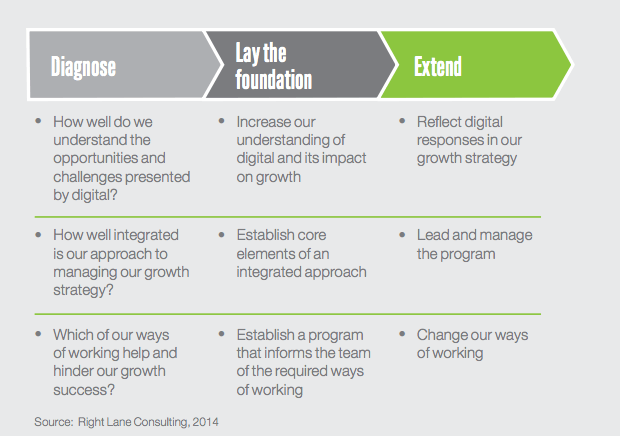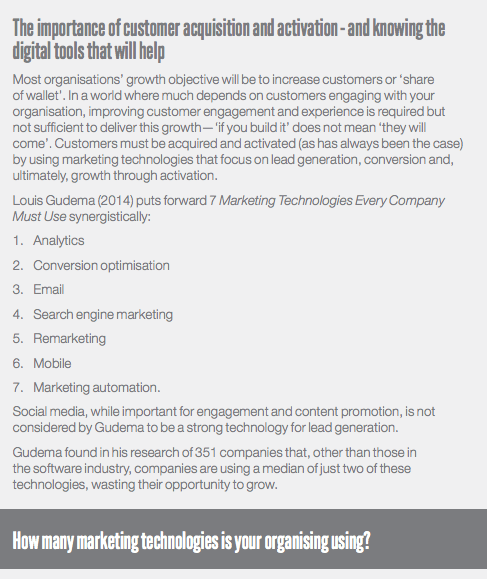Growth in a digital world
- Digital experiences are changing the competitive landscape
- Organisations that anticipate the future needs of their customers and improve the digital customer experience outperform their competitors
- To adapt a growth strategy for the digital world organisations should:
1. Rethink growth in the digital age
2. Develop an integrated approach to managing growth
3. Create a growth culture
By Brad McSwain and Julia Bentley
Digital experiences and solutions are redefining the competitive environment and how organisations grow.
Customers increasingly prefer online platforms, with today’s customers being more aware than ever of their purchasing options, and the majority even completing the buying process, before coming into contact with sales representatives. From the vendor’s perspective, digital tools can facilitate deeper customer engagement and the opportunity to deliver to new markets—and make it easier for new entrants to quickly gain share in traditional markets.
With the changes being brought about by new digital solutions and customer behaviours, many organisations cannot continue to operate in the same way and expect historic growth to persist. As a result, those organisations are adapting their growth strategies to focus on anticipating the future needs of the customer and improving the digital customer experience. And this has proven to be a successful strategy, with organisations rated in the top third of digital customer experience having 8.5 percent higher net margins and 7.8 percent higher revenue growth than their industry competitors (Weill & Woerner 2014).
Earlier in 2014 and in collaboration with David Ednie, CEO of SalesChannel Europe, we presented to clients ways to adopt digital solutions as part of a growth strategy. We believe every organisation should take the time to rethink growth in the digital age of the customer, develop an integrated approach to managing growth and create a growth culture.
Rethinking growth in the digital age of the customer
‘Old thinking X new technology = fail’ says David Ednie, CEO of SalesChannel Europe.
Traditional growth strategies typically begin with an assessment of whether an organisation is ahead or behind the growth curve within its market. For many, this assessment has been done periodically but generally infrequently; there has been neither the need nor the ability to assess more frequently. However, with the rapid rise of the digital customer in those markets, many organisations are quickly finding themselves behind the growth curve and, in an effort to keep up, are applying new technologies and solutions without considering how this fits into their overall growth strategy.
David points to five ways to rethink growth in this age of the digital customer.
1. Develop a growth mindset
A growth mindset in this digital age requires an ability to anticipate future changes in customers’ needs and preferences. Introducing new technologies for the sake of it is a wasted investment if customers will not engage. Instead of focusing on what new technologies can be applied to current services and products, organisations should first identify tomorrow’s customers – who they are and what they will want for the next 6 months, 6-12 months and 12-36 months. New technologies should only be introduced if they will improve engagement with tomorrow’s customers.
2. Differentiate or die
While product superiority is still an important factor for attracting customers, organisations need to spend more energy on developing tailored solutions for customers and then educate customers on why their service or product is more valuable than competitors’. This is particularly important in the digital age where customers can easily turn to online search engines to research and compare a range of services and products. To be clear on why and how it is different to competitors in terms of its service or product category, an organisation can differentiate three levels:
(i) Basic product/service: technology, price performance, product/service quality
(ii) Support services: levels of support; quality of service, systems and processes
(iii) End-to-end customer experience: people, perceived value, high touch, exceed customer expectations, delight and astound customers.
3. Review the customer adoption cycle
In considering the needs of tomorrow’s customers, organisations also need to consider their purchasing behaviours. A CEB study of more than 1,400 customers found that today’s customers are completing 57% of a buying cycle before ever coming into contact with a sales representative (Adamson, Dixon & Toman 2012). The internet and mobile devices enable customers to search, find, qualify and try products and services before contacting a vendor and making a decision.
This means that, for many organisations, a new customer adoption cycle is required for their business. This new cycle aligns sales, marketing and customer interactions, moving away from traditional view of the buying process as a process of ‘awareness’, ‘consideration’, ‘decision’ and then ‘purchase’, which is too simplistic and does not take into account the multiple factors that can influence a buyer’s decision.
4. Disrupt the status quo
‘Fire your sales force’ says Tiffani Bova, Vice President and distinguished analyst responsible for IT sales and channel strategies at Gartner Research (2014).
The old golden rule in sales was: find out what your customers want and give it to them. The new rule is: give your customers the ability to do what they can’t currently do but would want to if they only knew it was possible. Bova argues that implementing this new rule requires a different capability to a sales force: the ability to understand and capture customers’ imaginations, particularly in the digital age where we are only beginning to understand the opportunities presented by technology. As Keven Roberts (2012), CEO of Saatchi & Saatchi Worldwide has said ‘reasons lead to conclusions; emotions lead to actions’. People will make decisions when they are faced with immediate negative consequences. The new rule requires sales and marketing teams to take the customer out of the comfort and complacency of the status quo and let them ‘wallow’ in the negative future without your service or product.
5. Tip the funnel
‘Tip the funnel’ and convert your customers into your unpaid and more effective sales team. Recommendations from customers to their personal contacts have an 88 percent conversion rate compared to 4 percent for cold calling and 44 percent for external recommendations (Ednie 2014). For this reason, many organisations have tapped into social media such as Facebook, Twitter and YouTube as a method of encouraging customers to promote products and services to friends online.

Taking an integrated approach to managing your growth strategy
Amidst this digital disruption and in an increasingly competitive environment, it is more important than ever for organisations to take a structured and integrated approach to managing a growth strategy. A clear plan for achieving growth enables organisations to have a better idea of what is working and what can be improved.
An integrated growth strategy includes five dimensions.
1. Articulate a clear growth aspiration
The clarity of an organisation’s growth aspiration and the levers that will be pulled are critical to the success of a growth strategy. Without this, an organisation’s ability to manage and lead will be undermined.
Key questions that organisations should ask when articulating a growth aspiration include:
- Have we been sufficiently granular on where we will grow?
- Do we know the ‘sizes of the pies’, and will they realistically get us to our aspiration?
- Have we considered what our competitive advantages will need to be, or what will make us distinctive?
- What is the context within which we will grow? What is happening in our industry? Are our customers changing?
- Have we translated these into ‘levers’ that are readily understood within our business?
2. Align resources with your strategy
Resources should be directed at the levers that are most likely to drive growth. Assess the current allocation of growth resources, prioritise the levers that are likely to have the greatest impact on the growth aspiration and propose to redirect resources to these priority levers.
3. Actively lead the program
Organisations implementing a new growth strategy can learn from effective change management, where contributors to success include active and visible executive sponsorship and frequent and open communications about the need for change. There needs to be a structured management approach, backed by dedicated resources and funding and supported by employee engagement and participation.
4. Adopt effective disciplines to manage the program
Setting up an operating rhythm that focuses management’s time on measuring, monitoring and review ensures regular tracking of progress against the growth strategy. Calling on a fact base to track which levers are contributing to growth can help an organisation to monitor progress and make decisions about which levers should be continued or discontinued.
5. Build and maintain a fact base
Compiling and maintaining a fact base enables organisations to make informed decisions. This fact base should include the data required to track performance and the desired targets over time as well as a regular assessment of the external environment, particularly in an increasingly changing growth environment.
Creating a growth culture and ways of working
Organisations don’t change, people do. So how do organisations get their team onboard with a new growth mindset? David Ednie believes it comes down to personal accountability. Leaders need to own the change if they are going to drive organisation-wide change.
In particular, David points to five ways that leaders can create a growth culture.
1. Be future focused
Look forward. Let go of the past and take a higher level view to anticipate the next ‘wave’.
2. Shift your mindset
A new mindset precedes new results. A fixed mindset assumes that intelligence is static, leads to a desire to look smart and a tendency to avoid challenges and ignore useful feedback. Conversely a growth mindset assumes that intelligence can be developed and leads to a desire to learn, embrace challenges, persist despite obstacles, learn from criticism and be inspired by others’ success (Dweck 2006).
3. Manage two businesses
Managing growth requires agility and asymmetrical thinking. Organisations should consider lessons from the different techniques in rafting and rowing. Row boats are structured and only suitable for travelling down calm and flat rivers. On the other hand, raft boats allow one to adapt to the environment and travel down changing and challenging waters. Organisations can often fall into the trap of travelling down flat rivers and having a predictive mindset. Be future focused and set up like a raft to be agile in a changing environment.
4. Develop ambidextrous thinking
Organisations need to develop ambidextrous thinking – how to use ‘AND Thinking’ as a tool to discover new solutions, approaches and ideas that fly in the face of the established way of doing things. On hearing a new idea, try responding with AND rather than BUT.
5. Have an experimental mindset
Organisations should embrace the certainty of failure using a ‘disciplined experiment’ mindset. Gamify the thinking and the business.
Immediate steps to getting started on a growth strategy
The digital age may seem daunting as the competitive environment changes; however, there are some simple steps that have been covered here that organisations can take to get started on their growth strategies. Regardless of whether an organisation chooses to focus on digital technologies, start by diagnosing the situation and developing a better understanding of the current environment; then lay the foundations to establish core elements of the integrated approach; and finally extend the growth strategy into the organisation.

Want to know more?
If you would like Right Lane to help your company grow in this digital world, contact Lauren Spiteri: lauren@rightlane.com.au
References
Adamson, B, Dixon, M & Toman, N 2012, The end of solution sales, Harvard Business Review, viewed 12 November 2014, <https://hbr.org/2012/07/the-end-of-solution-sales>
Burrus, D 2014, Transform … or Perish, July 2014, <http://www.burrus.com/resources/daniel-burrus-download-center/transformor-perish/>
Dweck, C 2006, Mindset: the new psychology of success, Random House, New York.
Ednie, D 2014, Rethinking growth in a digitally disrupted age of the customer, viewed 12 November 2014, <http://www.slideshare.net/dednie/rethinking-growth>
Gartner 2014, The future of IT sales: a new way forward, viewed 12 November 2014, <http://www.gartner.com/technology/research/future-of-it-sales/>
Gudema, L 2014, 7 Marketing Technologies Every Company Must Use, Harvard Business Review, November.
Roberts , K 2012, Reasons lead to conclusion; emotions lead to action, viewed 12 November 2014, < http://www.saatchikevin.com/interview/reasons-lead-conclusion-emotions-lead-action/>
Weill, P & Woerner, S 2014, Engaging your customers digitally, Revitalizing your digital business model conference, Boston, 15 July 2014
